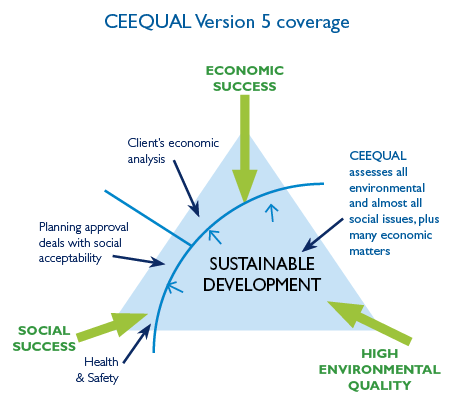CEEQUAL & Sustainability
Using the three-pillar model of sustainable development – which seeks to achieve economic, social and environmental success at the same time and is thus connected to triple-bottom-line reporting – CEEQUAL can be seen to complement the planning system and clients’ financial and economic models. It assesses a wide range of economic, environmental and social issues, including a project or contract’s effects on neighbours, and community relations more generally.
In 2012, a Project Strategy Section was added to CEEQUAL for Projects, and a Client Contract Strategy Section to CEEQUAL for Term Contracts. CEEQUAL therefore now includes assessment of ‘worthwhileness’ alongside indirect economic issues through consideration of energy, materials and waste that can significantly influence the financial outcome of a project or contract. It also covers the wider economic, social and environmental impacts and benefits of the project or contract. CEEQUAL as a rating system does not assess the wisdom of clients or the planning system in promoting and allowing works to proceed. However, it does assess whether a project or contract is helping the community(ies) it serves to live more-sustainably.
By promoting the development of appropriate strategies, and the use of environmental and social best practice, and then measuring environmental and social performance, CEEQUAL is now a tool that assesses the full sustainability credentials of projects and contracts. It also supports the strategies of the UK Government and other Governments by providing the infrastructure professions and industry worldwide with an incentive and protocol for assessing, benchmarking and rating the sustainability performance of projects and contracts as part of the industry’s contribution to sustainable development.
 |
The regular updating and upgrading of CEEQUAL has led to a progressive widening of its scope. The graphic illustrates the current almost-complete coverage in CEEQUAL of all of the characteristics of a ‘sustainable development’. This leaves decisions on whether to proceed with projects where the CEEQUAL team and users believe they belong: with clients and the planning authorities.
Click here to view CEEQUAL's place within the civil engineering industry
